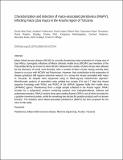Characterization and detection of maize-associated pteridovirus (MaPV), infecting maize (Zea mays) in the Arusha region of Tanzania

View/
Date
2019-03-01Author
Read, David
Featherston, Jonathan
Rees, David
Thompson, Genevieve
Roberts, Ronel
Flett, Bradley
Mashingaidze, Kingstone
Pietersen, Gerhard
Kiula, Barnabas
Kullaya, Alois
Mbega, Ernest
Metadata
Show full item recordAbstract
Maize lethal necrosis disease (MLND) is currently threatening maize production in a large area of East Africa. Synergistic infections of Maize chlorotic mottle virus (MCMV) and members of the Potyviridae family are known to elicit MLND. Metaviromics studies of plant viruses have allowed for the discovery of novel viral diversity, with a number of these viruses having recently been shown to co-occur with MCMV and Potyviruses. However, their contribution to the expression of disease symptoms still requires extensive research. In a survey for viruses associated with maize in Tanzania, 35 samples were sequenced using an RNA-tag-seq metaviromics approach. Bioinformatic analysis of assembled reads yielded two contigs (5.8 and 2.7 kbp) that shared sequence homology with RNA1 and RNA2 of the dsRNA Japanese holly fern mottle virus (JHFMoV) (genus: Pteridovirus) from a single sample collected in the Arusha region. RNA1 encodes for a polyprotein product containing putative viral methyltransferase, helicase and polymerase domains. RNA2 contains three open reading frames (ORFs), one of which encodes for a putative movement protein, while the remaining two encode for putative products with no known function. The tentative name Maize-associated pteridovirus (MaPV) has been proposed for the virus in this study.
